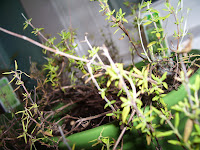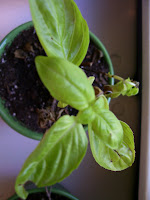
FRESH AIR
The air inside your home may be up to 10 times polluted as the air outside. Considering we spend 65% of our time in our homes and up to 90% of time indoors all together, the quality of air we breathe is something to think about.
Pollutants enter our homes in a variety of ways. Attached garages can bring automobile exhaust inside. We track pesticides and other chemicals in on the bottom of our shoes. Heavily scented laundry products waft toxic chemicals. Gas cooking appliances vent carbon monoxide. A Teflon treated non-stick pan overheated on the stove releases PFOA/PTFE's. Automatic dishwasher detergent containing chlorine combines with heat to create dioxin, a probable human carcinogen. The paint on our walls off gas VOC's. Cleaning supplies and personal care products we use host hoards of dangerous chemicals. Dry cleaning hanging in the closet discharges PERC. Burning candles/incense and air fresheners do more than scent the air we breathe. The furniture we sit on and the mattress we sleep on are laden with flame retardants containing PBDE. We surround ourselves with a lengthy list.

One way to combat the constant barrage of self inflicted pollution is by adding a little green to your household. Green plants that is. Plants influence air quality within a personal breathing zone of 6 to 8 cu. ft. In 1980 NASA's John C. Stennis Space Center first discovered that houseplants could remove VOCs from sealed test chambers. Houseplants are effective in removing Acetone, Methyl alcohol, Ethyl acetate, Benzene, Ammonia, Trichloroethylene, Formaldehyde and Xylene as well as bioeffluents. Plants also release phytochemicals that suppress mold spores and bacteria found in air. Research shows that plant filled rooms contain 50 to 60 percent fewer airborne molds and bacteria than rooms without plants.
Pollutants enter our homes in a variety of ways. Attached garages can bring automobile exhaust inside. We track pesticides and other chemicals in on the bottom of our shoes. Heavily scented laundry products waft toxic chemicals. Gas cooking appliances vent carbon monoxide. A Teflon treated non-stick pan overheated on the stove releases PFOA/PTFE's. Automatic dishwasher detergent containing chlorine combines with heat to create dioxin, a probable human carcinogen. The paint on our walls off gas VOC's. Cleaning supplies and personal care products we use host hoards of dangerous chemicals. Dry cleaning hanging in the closet discharges PERC. Burning candles/incense and air fresheners do more than scent the air we breathe. The furniture we sit on and the mattress we sleep on are laden with flame retardants containing PBDE. We surround ourselves with a lengthy list.

One way to combat the constant barrage of self inflicted pollution is by adding a little green to your household. Green plants that is. Plants influence air quality within a personal breathing zone of 6 to 8 cu. ft. In 1980 NASA's John C. Stennis Space Center first discovered that houseplants could remove VOCs from sealed test chambers. Houseplants are effective in removing Acetone, Methyl alcohol, Ethyl acetate, Benzene, Ammonia, Trichloroethylene, Formaldehyde and Xylene as well as bioeffluents. Plants also release phytochemicals that suppress mold spores and bacteria found in air. Research shows that plant filled rooms contain 50 to 60 percent fewer airborne molds and bacteria than rooms without plants.
According to the book How to Grow Fresh Air, 50 Houseplants that Purify Your Home or Office by Dr. B.C. Wolverton here are a few of the top rated plants.
 Palms:
Palms:
Areca Palm (Chrysalidocarpus lutescens) rated 8.5 out of 10
Lady Palm (Rhapis excelsa) - 8.5
Bamboo Palm (Chamaedorea seifrizii) - 8.4
*All require semi-sun & 65-75 degree home temperature. The two palms pictures above are of my 8 foot tree.
Rubber Plant (Ficus robusta) - 8.0
*Semi-sun to semi-shade & 60-80 degrees. Especially effective at removing formaldehyde. It is the taller plant on right side table top, deep green/burgundy leaves.
Dracena "Janet Craig" (Dracena deremensis "Janet Craig") - 7.8
*Semi-shade; will tolerate dimly lit areas, but growth will be slow. 60-75 degrees.
It is one of the best plants for removing trichloroethylene.
Little plant pictured above to the right of the rubber plant.
English Ivy (Hedera helix) - 7.8
*Semi-sun to semi-shade. Day: 60-70 degrees; night: 50-60 degrees.
Boston Fern (Nephrolepis exaltata "Bostoniensis") - 7.5
*Semi-sun. Day: 65-75 degrees; night: 50-65 degrees.
It is the best for removing air pollutants, especially formaldehyde, and for adding humidity to the indoor environment. Shown above on left table top, back side.
Peace Lily (Spathiphyllum sp.) - 7.5
*Semi-sun to semi-shade. Day: 60-75 degrees; night: 55-68 degrees.
The peace lily excels in removal of all alcohols, acetone, trichloroethylene, benzene and formaldehyde.
 Golden Pothos (Epipremnum aureum) - 7.5
Golden Pothos (Epipremnum aureum) - 7.5
*Semi-shade to shade & 65-75 degrees.
This plant is damn near indestructible! It can withstand severe neglect. Great for those with black thumbs!
Spider Plant (Chlorophytum comosum) - 5.4
*Semi-sun to semi-shade. Day: 65-75 degrees; night: 55-65 degrees. Again, a good plant for the growing challenged. (Shown further down.) I have had this one since I moved to college over 14 years ago. It has survived drought, famine, no sun, all sun. Hell, it even froze a time or two! Very hardy.
Green plants are a fairly inexpensive addition to your home. Plus, they are an easy way to decorate.
They also serve more than an ornamental purpose.





 Palms:
Palms:Areca Palm (Chrysalidocarpus lutescens) rated 8.5 out of 10
Lady Palm (Rhapis excelsa) - 8.5
Bamboo Palm (Chamaedorea seifrizii) - 8.4
*All require semi-sun & 65-75 degree home temperature. The two palms pictures above are of my 8 foot tree.
Rubber Plant (Ficus robusta) - 8.0
*Semi-sun to semi-shade & 60-80 degrees. Especially effective at removing formaldehyde. It is the taller plant on right side table top, deep green/burgundy leaves.
Dracena "Janet Craig" (Dracena deremensis "Janet Craig") - 7.8
*Semi-shade; will tolerate dimly lit areas, but growth will be slow. 60-75 degrees.
It is one of the best plants for removing trichloroethylene.
Little plant pictured above to the right of the rubber plant.
English Ivy (Hedera helix) - 7.8
*Semi-sun to semi-shade. Day: 60-70 degrees; night: 50-60 degrees.
Boston Fern (Nephrolepis exaltata "Bostoniensis") - 7.5
*Semi-sun. Day: 65-75 degrees; night: 50-65 degrees.
It is the best for removing air pollutants, especially formaldehyde, and for adding humidity to the indoor environment. Shown above on left table top, back side.
Peace Lily (Spathiphyllum sp.) - 7.5
*Semi-sun to semi-shade. Day: 60-75 degrees; night: 55-68 degrees.
The peace lily excels in removal of all alcohols, acetone, trichloroethylene, benzene and formaldehyde.
 Golden Pothos (Epipremnum aureum) - 7.5
Golden Pothos (Epipremnum aureum) - 7.5*Semi-shade to shade & 65-75 degrees.
This plant is damn near indestructible! It can withstand severe neglect. Great for those with black thumbs!
Spider Plant (Chlorophytum comosum) - 5.4
*Semi-sun to semi-shade. Day: 65-75 degrees; night: 55-65 degrees. Again, a good plant for the growing challenged. (Shown further down.) I have had this one since I moved to college over 14 years ago. It has survived drought, famine, no sun, all sun. Hell, it even froze a time or two! Very hardy.
Green plants are a fairly inexpensive addition to your home. Plus, they are an easy way to decorate.
They also serve more than an ornamental purpose.
Herbs in a sunny window provide a kick to your cooking.




Flowering plants provide color and hope during the long winter months.

Aloe vera soothes sunburn and minor cuts.

Many plants can be easily propagated from cuttings. Perhaps a friend or relative would give you a leaf or small cutting to start your own plant. Or, maybe you have some to share. Leaves from African Violets can be broke off, stuck in dirt and will grown into a new plant.



Many plants can be easily propagated from cuttings. Perhaps a friend or relative would give you a leaf or small cutting to start your own plant. Or, maybe you have some to share. Leaves from African Violets can be broke off, stuck in dirt and will grown into a new plant.


Jade cuttings can be placed in water until roots form and then planted.




 Consider adding a plant to the areas you hang out in the most. Next to the couch, on your computer desk, near your bed, in the kitchen. No room is off limits, think bioeffluents!
Consider adding a plant to the areas you hang out in the most. Next to the couch, on your computer desk, near your bed, in the kitchen. No room is off limits, think bioeffluents!
Plants are cheap or free if you use cuttings. They improve the air quality, comfort and overall aesthetic of your home. They are quiet and require no electricity.


The off shoots of Spider plants are easily rooted to transform into their own plants as well.


 Consider adding a plant to the areas you hang out in the most. Next to the couch, on your computer desk, near your bed, in the kitchen. No room is off limits, think bioeffluents!
Consider adding a plant to the areas you hang out in the most. Next to the couch, on your computer desk, near your bed, in the kitchen. No room is off limits, think bioeffluents!Plants are cheap or free if you use cuttings. They improve the air quality, comfort and overall aesthetic of your home. They are quiet and require no electricity.
How pure is the air you breathe?





















3 comments:
Thank you so much for this wonderful post! If the photos in it are yours, you seem to have quite an array of beautiful houseplants. I have always loved plants and thought that they oxygenated the air, but didn't realize they were so effective at removing toxins and molds! Our entry way is packed with plants, but I haven't gotten the courage to spread them beyond that room since my young toddler would surely eat the dirt for a noontime snack. Still, your post inspires me to maybe try some hanging plants in the rest of our home. Thanks so much for contributing your wisdom to our Thrifty Green Thursday!
I also did not know that plants could do so much! I have quite a few houseplants, but they don't look so great. I don't have much of a green thumb, so the ones that have survived are very hearty indeed. That's great to know that they're ridding my house of toxins.
Also, now I want to get an aloe vera plant and start an indoor herb garden.
Thanks for joining us again for TGT!
There's a BOOK called "How to Grow Fresh Air"? That's so cool! I've known that plants purify the air but I never figured out which plants and by how much. Nice to get learn something concrete!
Post a Comment